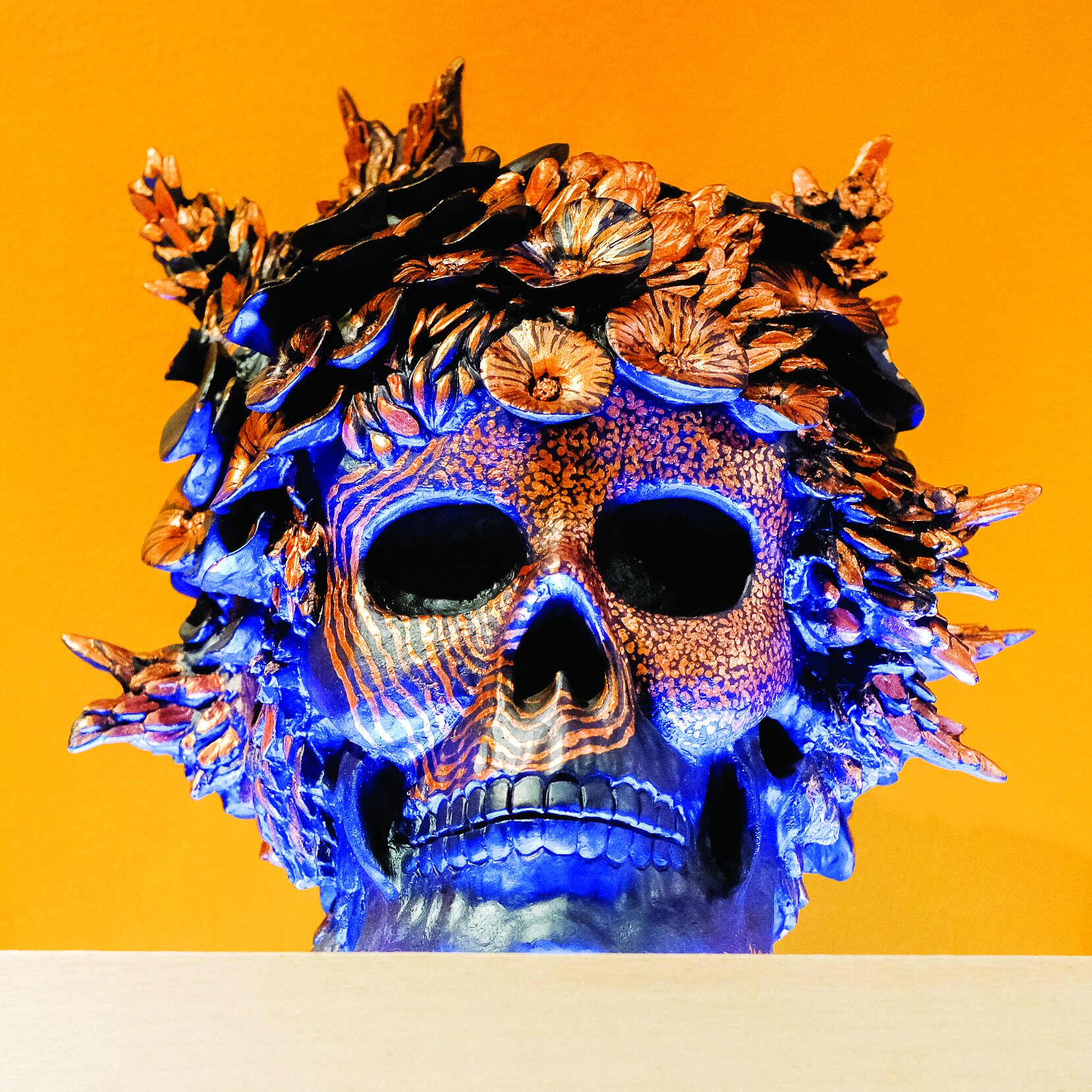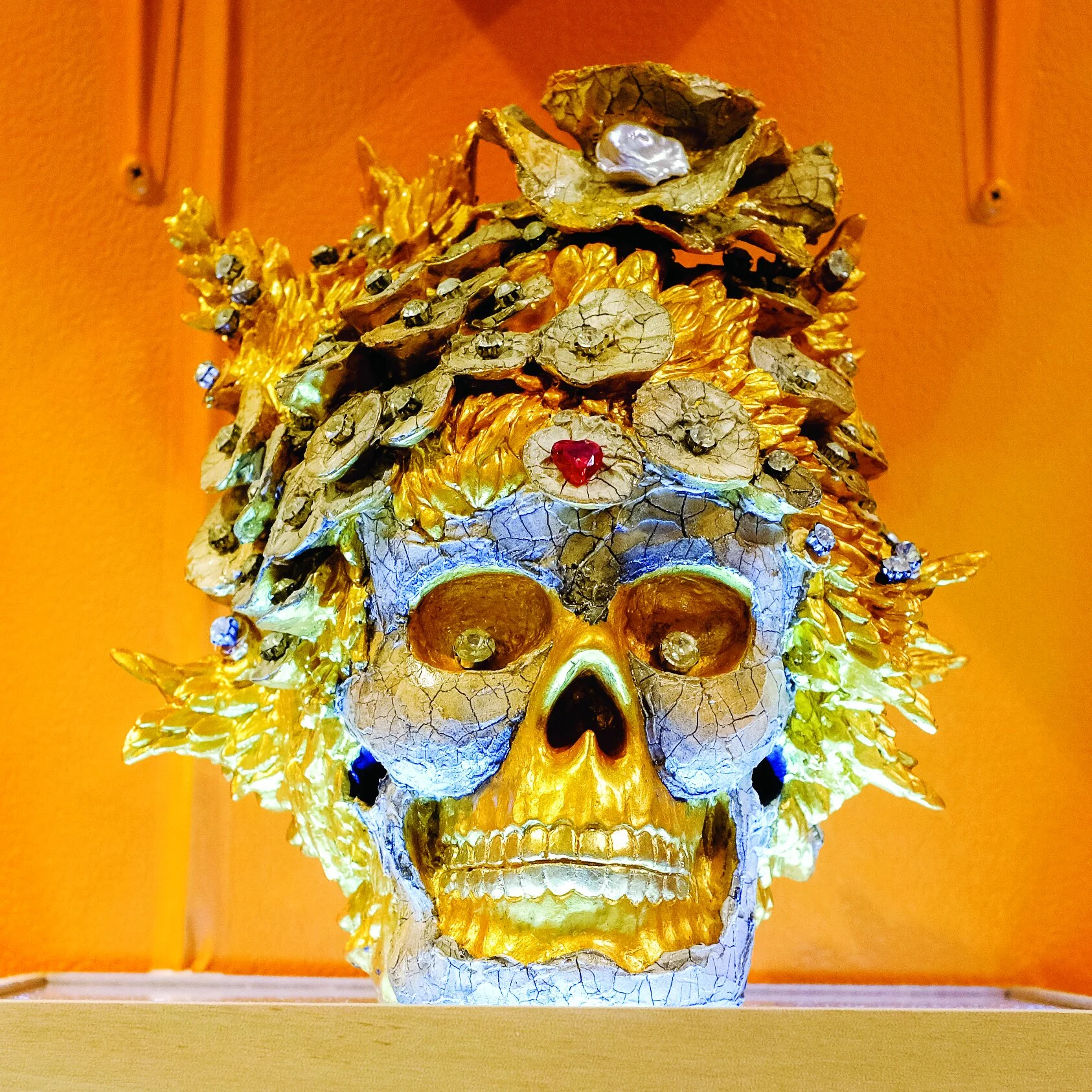Symbol of Rebirth
Fundacion Sansó launches Past Expressing, a unique fundraising exhibit with noted Filipino artists for the benefit of Fine Arts students.
Images courtesy of Fundacion Sansó
February 1, 2023
Fundacion Sansó scholars who took part in “Pamana sa Panahon ng Pagbabago”
The skull has long been a symbol of death and impending mortality. But somehow, the skull can also a symbol of the afterlife and a rebirth of sorts. This concept was explored in Fundacion Sansó’s exhibit, Past Expressing, which ran from October 22 to November 12. For this, Fundacion Sansó commissioned artist Pepe Mendoza to create and cast a resin sculpture inspired by Juvenal Sansó’s Expressionist paintings and illustrations of a skull wreathed with flowers.
Mendoza’s reinterpretations of Sanso’s Baudelarian skulls – which were introduced in MoCAF (Modern Contemporary Art Festival) last July – are lit from within, giving each skull an otherworldly glow. His black resin skulls, which were commissioned for this exhibit, provided a blank canvas for each artist.
These skulls were given to 17 noted Filipino guest artists – including Agnes Arellano, Richard Buxani, Michael Cacnio, Teo, Jonathan Dangue, Anton Del Castillo, Janos Delacruz, Louie Ignacio, Toym Imao, Kristine Lim, Pepe Mendoza, Kenneth Montegrande, Francis Nacion, Roel Obemio, Marge Organo, Jomike Tejido, and Melissa Yeung Yap – to interpret with their medium or technique of choice. This fundraising exhibit, held in partnership with Art Lounge Manila, will benefit the Sansó Stipend Fund for select Fine Art Students of Bulacan State University College of Architecture and Fine Arts.
Agnes Arellano’s “Untitled”
Jonathan Dangue’s “Masquerade”
Janos Dela Cruz’s “Morpheus - King of Dreams”
Louie Ignacio’s “Homage to Sanso”
The secret of the skull
“Past Expressing,” the main Sansó artwork on which this exhibit is named after, is a 1960 colored ink work cited by the artist in the 1988 book Sansó: Art Quest Between Two Worlds by Rod. Paras-Perez.
Here, Sansó explains: “These are basically inspired by a phrase in Baudelaire’s Artificial Paradises which is a very powerful recreation from Quincy’s The Opium Eaters. It is about an opium addict and a description of his nightmares. One of the phrases is about a human skull beautifully decorated with flowers, so I took that out and made many, many studies of a skull with a wreath on its head.”
These Baudelarian skulls, which are both macabre and beautiful, appeared around the same time Sansó created his other Expressionist works. The skulls became one of the iconic themes of his Black Period in the 1950s to 60s, when the artist was still coming to terms with his trauma from the death and destruction of World War II. His “Capped With Flowers” ink painting for example, done in 1958, shows not a skull but the full face of a woman with a flower wreath on her head. What could have been a pleasant and dainty painting turns sinister with her flushed skin and menacing eyes.
It is interesting to note that around this particular period, Sansó created his floating oval bouquets, some with grotesque human heads that, along with his floral skulls, were precursors of his popular flower and En Vase series of paintings. The artist revisited the skull theme recently with his 2014 sculpture, “Homage to Baudelaire.”
Artistic interpretations
In Past Expressing, each of the guest artists’ interpretations of the skull with flowers are endlessly fascinating. Jomike Tejido created a whimsical, interactive skull by attaching an abstract mobile. Melissa Yeung Yap revisited traditional “Day of the Dead” motifs with her colorful “Skullywag.” Kenneth Montegrande lent his signature paint daubs to his skull, turning it into an abstract work. Meanwhile, painter and printmaker Janos Delacruz gave a nod to Juvenal Sansó’s printmaking past with a skull enrobed in prints.
Sculptors Michael Cacnio and Richard Buxani went back to their material roots in metal—Cacnio with a hand sculpture cradling the skull, and Buxani with a bronze-and-gold palette for his work “Metallic Overture.” Teo nestled a skull into a complex assemblage panel. Toym Imao, on the other hand, presented a human head that breaks open to reveal the skull underneath, rendered playfully and not grotesquely.
Skulls and scholars
As varied as the skull interpretations may be, the exhibit’s main goal was to support deserving art students from Bulacan State University. When Fundacion Sansó was created, Juvenal Sansó expressed his wish to establish a scholarship for art students, as he was one himself, and the Sansó Student Stipend Fund was created.
The Sansó Stipend Fund is currently providing scholarships to its 4th batch of art scholars from Bulacan State University. In this process of altruism, the Baudelarian skulls become instead symbols of hope and new beginnings, of an artist’s dark past expressing a brighter future.
Installation view of Past Expressing
Complementing the show is a second exhibition titled Pamana sa Panahon ng Pagbabago featuring works by Fundacion Sansó’s current batch of scholars. These include Noreen Alfonso, Jack De Castro, Geofrey Allan Diezma, John Niño S. Esguerra, Charles Andrei Espiritu, Kent Francis Macapagal, John Miguel St. Montemayor, Marc Louie Punongbayan, and Miguel Voluntad, who created works inspired by the idea of the intangible heritage passed on to the next generations, particularly in a world adapting to vast social changes. In a happy turn of events, artist Kenneth Montegrande purchased all of the scholars’ artworks, thus encouraging the young budding artists to keep on pursuing their craft.
Michael Cacnio artwork for Past Expressing
Fundacion Sansó is located at 32 V. Cruz St., Brgy. Sta. Lucia, San Juan City. For more information, email Fundacion Sansó at [email protected]. Follow them on Instagram @fundacion_sanso and on Facebook (FUNDACIONSANSO).







